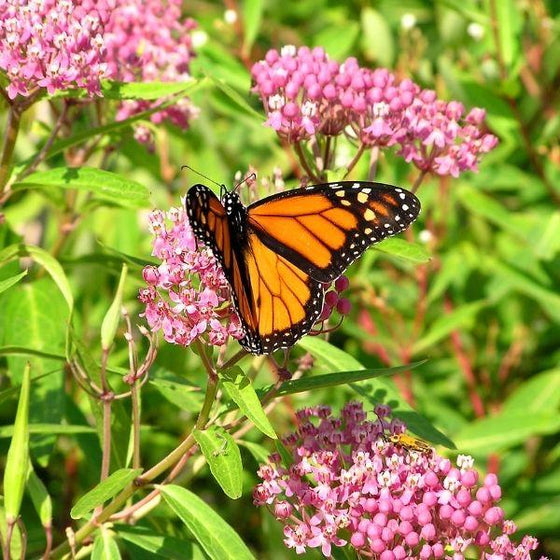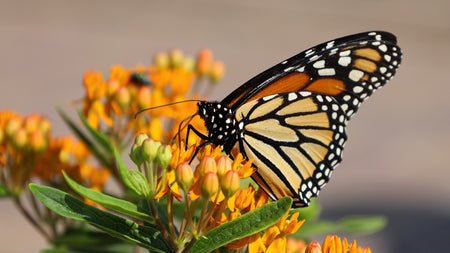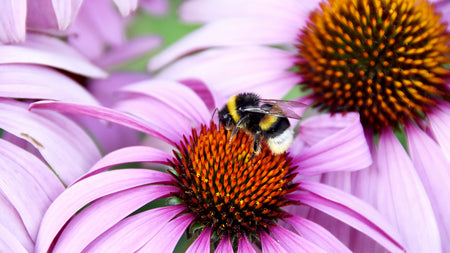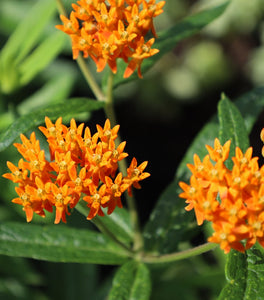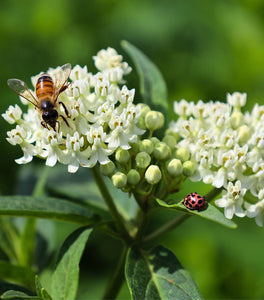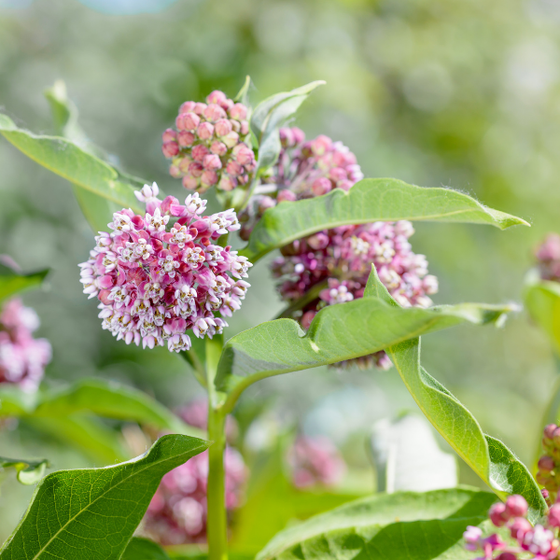
Images Depict Mature Plants
Swamp Milkweed Plants for Sale Online
Swamp Milkweed (Asclepias incarnata) is a hardy, moisture-loving perennial known for its vibrant clusters of pink, mauve, or white flowers that attract a wide range of pollinators, including monarch butterflies. Thriving in USDA Hardiness Zones 3-8, this native North American plant grows 3-5 feet tall and spreads about 2-3 feet wide, making it a stunning addition to rain gardens, wetland areas, and naturalized landscapes. Swamp Milkweed is particularly valued for its role in supporting monarch butterfly populations, as it provides essential nectar and serves as a host plant for monarch caterpillars.
Perfect for planting in areas with consistently moist to wet soils, Swamp Milkweed excels in rain gardens, pond edges, or low-lying areas where water tends to collect. While it prefers moist conditions, this adaptable perennial can also tolerate drier soils once established, making it a versatile choice for a variety of landscapes. In mid-to-late summer, its fragrant blooms attract bees, butterflies, and other beneficial insects, turning your garden into a hub of pollinator activity. The plant's narrow, lance-shaped leaves add texture to garden beds, and the upright stems provide height and structure.
In addition to its ecological benefits, Swamp Milkweed is low-maintenance and easy to grow. Plant it in full sun to partial shade, and it will thrive with minimal care. This deer-resistant perennial not only adds beauty and biodiversity to your garden but also plays a critical role in supporting native wildlife. Whether used in pollinator gardens, rain gardens, or as part of a naturalized planting, Swamp Milkweed delivers long-lasting color and environmental benefits to any outdoor space.

| Hardiness Zone: | 3-9 |
|---|---|
| Mature Height: | 3 to 4 Feet |
| Mature Width: | 2 to 3 Feet |
| Classification: | Perennial |
| Sunlight: | Full sun |
| Habit: | Upright, clump forming |
| Flower Color: | Lavender |
| Flowering Season: | Mid-June through frost |
| Foliage: | Green, licorice scented |
| Water Requirements: | Water well until established |
| Uses: | Extremely attractive when used as a focal point in the mixed border, mass planting. Attracts pollinators and hummingbirds |
How to Care for Swamp Milkweed
Before you buy a Swamp Milkweed make sure to read about the recommended care instructions to keep this plant healthy and thriving.
How do I Plant Swamp Milkweed?
To plant Swamp Milkweed, choose a location with full sun to partial shade and consistently moist to wet soil, as this native perennial thrives in damp environments like rain gardens, pond edges, or low-lying areas. Dig a hole about twice as wide and just as deep as the plant's root ball, and place the Swamp Milkweed in the hole with the crown at soil level. Backfill with soil, pressing down gently to remove any air pockets, and water thoroughly to help the plant establish. Space plants about 2-3 feet apart to allow for their mature size, which can reach up to 3-5 feet in height and 2-3 feet in width. Mulch around the base of the Swamp Milkweed to retain moisture and suppress weeds, but avoid covering the crown of the plant. During the first growing season, keep the soil consistently moist to help the plant develop a strong root system. Once established, Swamp Milkweed is relatively low-maintenance and can even tolerate short periods of dry conditions, although it prefers wet soils. This easy-to-grow perennial is perfect for adding vibrant color and attracting pollinators like monarch butterflies and bees to your landscape, making it a valuable addition to rain gardens, naturalized areas, or any spot with rich, moist soil.
How do I Water Swamp Milkweed?
To properly water Swamp Milkweed, ensure the soil remains consistently moist, especially during its first growing season to help establish a strong root system. This moisture-loving plant thrives in wet conditions, so watering deeply 2-3 times a week is recommended if planted in drier areas or during prolonged dry spells. If planting Swamp Milkweed in a rain garden or near a water source like a pond or stream, nature will likely provide sufficient moisture, but supplemental watering is necessary during dry periods to maintain healthy growth. Once established, Swamp Milkweed becomes more drought-tolerant, but it still prefers consistently moist soil for optimal growth and blooming. Check the soil regularly, especially in hotter climates, and water when the top 2-3 inches of soil feel dry. Mulching around the base of the plant will help retain moisture and reduce the need for frequent watering. By keeping the soil evenly moist, you’ll ensure that Swamp Milkweed thrives, producing vibrant pink blooms that attract pollinators like monarch butterflies while adding beauty and ecological value to your landscape.
How do I Fertilize Swamp Milkweed?
To fertilize Swamp Milkweed using organic fertilizer, start by applying a layer of compost or well-rotted manure around the base of the plant in early spring. This organic material provides essential nutrients while improving soil structure and moisture retention, which is crucial for this moisture-loving perennial. Spread about 1-2 inches of compost or organic matter evenly around the plant, keeping it a few inches away from the stems to prevent rot. As the compost breaks down, it will release nutrients slowly, encouraging healthy root development and vibrant growth throughout the season. You can also use organic liquid fertilizers, such as fish emulsion or compost tea, to feed Swamp Milkweed during the growing season. Apply the liquid fertilizer every 4-6 weeks, especially during the blooming period, to promote lush foliage and abundant flowers. Be sure to water the plant thoroughly before and after applying liquid fertilizer to help it absorb the nutrients more effectively. By using organic fertilizers, you'll support Swamp Milkweed's natural growth cycle while enhancing the plant’s ability to attract pollinators like monarch butterflies and bees, making your garden both beautiful and ecologically beneficial.

How do I Prune Swamp Milkweed?
To prune Swamp Milkweed, the best time is in late fall or early spring when the plant has finished blooming and the foliage begins to die back. Cut back the stems to about 6 inches above the ground to remove dead or damaged growth from the previous season. This not only tidies up the plant but also encourages new, healthy growth in the spring. Make sure to use clean, sharp pruning shears to prevent damage to the plant and reduce the risk of disease. Removing the dead stems also helps reduce the likelihood of pests overwintering in the plant material. Throughout the growing season, you can also perform light pruning to remove spent flowers, a practice known as deadheading. This encourages Swamp Milkweed to produce more blooms and extends the flowering period, which is especially beneficial for attracting monarch butterflies and other pollinators. If the plant becomes too tall or leggy, you can trim back the stems slightly in mid-summer to maintain its shape. Proper pruning ensures that Swamp Milkweed remains healthy, continues to provide vibrant blooms, and supports beneficial insects throughout the growing season.


